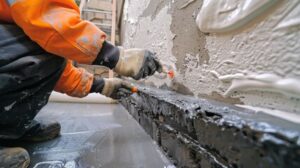Foundation repair is often more cost effective than foundation replacement. It also addresses the root causes of your problems, which is something that foundation replacement typically fails to do.

Horizontal cracks in your foundation walls are extremely worrisome and should always be addressed right away. They can indicate that your foundation is deteriorating at a dangerous rate. Visit https://www.apexplanofoundationrepair.com/ to learn more.
The most common method of foundation repair for houses and commercial buildings is concrete piles. These are thick, vertical pillars pushed deep into the soil to support the structure. They transfer the building’s load to the stronger layer of rock and gravel that sits several feet below the surface soil.
When choosing a concrete piling contractor, be sure that they are licensed, insured, and bonded. This will protect you as a homeowner and also ensure that the company meets local building codes. The best and most professional companies will use an evaluator to take various measurements inside the home, taking into account landscaping and bodies of water that might have had an effect on the soil around your house.
Once the evaluator has determined what needs to be done, they will recommend an appropriate repair solution and provide you with an estimate. A good foundation repair company will be transparent about their fees and any other expenses that may be involved with the project. They should also clearly explain when they can begin working on your foundation and how long the work will take.
During installation of concrete piles, it is important to understand that contractors will often be tempted to sell you on the number of pounds per square inch (PSI) pressure that they can apply to your pile. Be aware that this is a misleading figure, as it doesn’t tell you how much force is actually being applied to your pile. The only true way to determine if a pile is loaded is by using a gauge.
The best method of determining if your piles are loaded is by using a system called PileMedic. This system has been extensively tested over three years and is currently used by the Army Corps of Engineers. It is the only repair technique that has been approved for military use due to its ease of installation and ability to accurately measure loading.
The key to the PileMedic system is a unique design that utilizes the same high-strength epoxy used in construction and marine applications. The piles are pressed into the soil using a hydraulic machine and a high-powered ram that can generate up to 50,000 lbs of pressure on each pile. The system also uses a specially designed cylinder to keep the piles in place. This enables the piles to be installed faster and more precisely than traditional pile methods.
Poured Concrete Piers
Concrete foundation piers can be a good choice for homeowners and builders who want a durable, low maintenance option. Whether they are installed during new construction or decades later as part of a repair to a sinking foundation, these support piers redistribute the weight of the structure and surrounding soil across their surface. They have an impressive compressive strength that can stand up to environmental pressures and heavy loads, making them a long-lasting solution for many homes.
Poured concrete piers are a more cost-effective alternative to steel piers. However, their durability is largely dependent on the conditions underneath your home, which is why HD Foundations recommends that you have a soil test performed before choosing this type of foundation support pier. The testing process identifies the type of soil beneath your home and its load-bearing capacity, which will help you determine whether or not this type of pier is an appropriate solution.
The poured concrete method for installing piers requires digging holes under your foundation, filling them with wet concrete and allowing the concrete to cure before attaching it to your home. It is a quick fix for damaged foundations, but it does not address the underlying problem of poor soil compaction and often comes with a shorter warranty period than other types of piers.
Another popular pier and beam foundation option for new construction is the pressed piling method. In this approach, the work crew digs holes directly beneath your grade beam and uses a hydraulic tool to press 12-inch-tall precast concrete cylinders into the ground. Once the piers are in place, they can be used to lift sunken areas of your foundation.
This foundation repair option can be less costly than the drilled concrete option, but it is still a labor-intensive procedure that may require more masons than other types of piers. Like the drilled concrete method, it is important that you have your soil tested before selecting this type of foundation support pier. A professional can identify the type of soil in your yard and explain how it may affect the longevity of this pier and other repair options.
Steel Piers
Steel piers are the best long-term solution for foundation settling. They’re a bit more expensive than other methods, but they offer greater value over time by preventing future damage and reducing the need for future repair. They’re also considered permanent, making them a great investment for homeowners.
The main advantage of steel piers is that they’re extremely resistant to shifting soil. They’re driven into the ground until they reach bedrock, a solid support that prevents them from moving or being pushed aside. They’re also extremely durable and can withstand significant amounts of weight.
Pressed concrete piers can be used in some situations, but they require the soil to be relatively loose in order to install them. This can lead to them becoming unreliable over time. In addition, they’re susceptible to moisture swelling, which can compromise their strength and stability. This makes them a poor choice for areas with excessive rain or snowfall.
Helical piers and push piers are better choices for soil conditions that can’t be easily evaluated. They’re made of steel shafts with helix plates that screw into the earth until they reach a stable stratum. This process is quicker and more affordable than digging caissons, which requires the removal of large sections of the home’s floor.
Both of these types of piers are designed to distribute a structure’s weight evenly over the foundation. They can also be used to stabilize and restore foundations and masonry elements that have been damaged by moisture. These problems can be caused by water absorbed into the soil from rainfall or from leaky plumbing. They can also be caused by evaporation from heat or sunlight and a resulting imbalance of moisture in the soil beneath a foundation.
Unlike other foundation repair methods, installing steel piers can be completed in one to two weeks with minimal disruption to the structure. This can be a great benefit for families who want to minimize the disruption and stress of moving out temporarily while repairs are taking place. Steel piers are also more affordable than other foundation repair methods and provide peace of mind that they’ll be able to stand up to heavy use for many years.
Helical Piers
When your home’s foundation begins to shift, helical piers offer an effective way to lift it and stabilize the entire structure. These piers are made of galvanized steel and are screwed into the ground beneath your home until they reach bedrock or another more stable load-bearing stratum.
They can be used in both new construction and foundation repair projects, including residential homes, commercial structures and transportation infrastructure like highways and bridges. Helical piers are often preferred by engineers because they are easier to install than concrete piers and can be installed in tight spaces where other methods of excavation would be impossible or extremely costly.
Helical piers are also highly customizable to fit your specific needs. They are available in a variety of lengths, widths and thicknesses. This customization allows you to find the piers that can best support your structure, taking into consideration factors such as size, weight and soil conditions. Additionally, you can choose between a sleeve or a solid head. The type of pier you need will affect the price and installation timeframe.
In most cases, you will need a geotechnical survey done before having helical piers installed. This step is particularly important when dealing with older structures and in areas where the underlying soil is unstable. A reputable foundation repair contractor will be able to advise you on what options are available for your property.
During a helical pier installation, your foundation repair team will use painter’s tape to mark off the area where they will be installing the piers on your home. They will then excavate holes in the ground every six feet or so. Each pier will be screwed into the ground until it reaches the desired capacity and is then secured in place with hydraulic jacks. This process can take anywhere from a few days to a few weeks, depending on the size of your home and the number of helical piers needed to achieve the desired level of support.
The helical piers will be connected to brackets that are attached to the bottom of your foundation. The jacks will be used to apply pressure to the piers and then lift your foundation back into its original position. Once the piers are in place, your foundation repair contractor will make a visual inspection of your foundation and stucco walls to ensure that the piers have lifted your home as closely as possible to its original location.
